Benefon Dragon Operation Manual
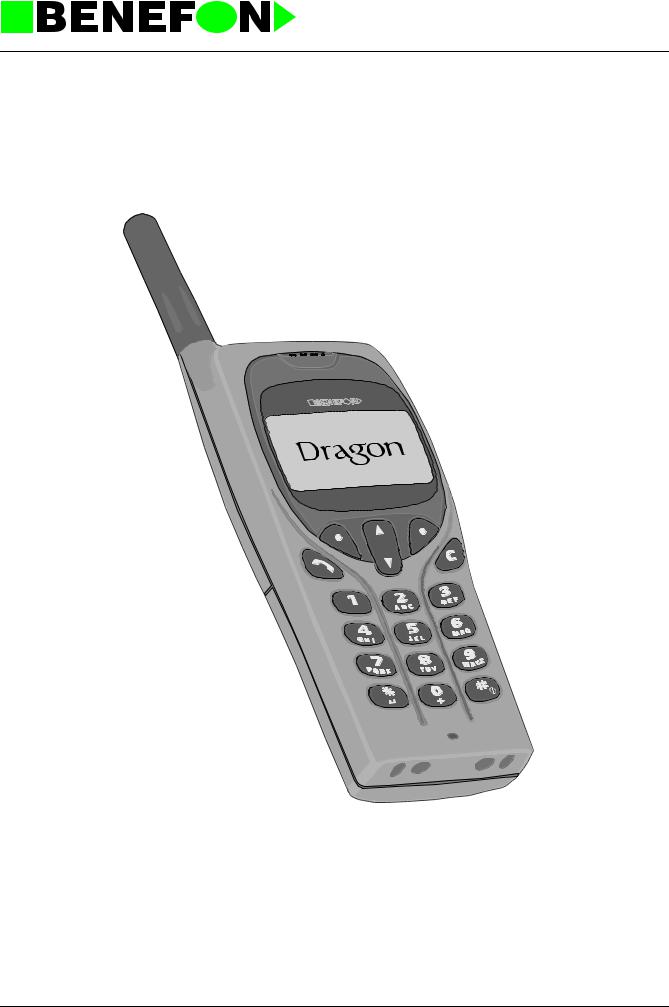
Product: TDP70WN /
5.9.2000
SERVICE MANUAL
BENEFON DRAGON
TDP70WN
Dp_70ngbTOC.fm |
1 |

Product: TDP70WN /
5.9.2000
CONTENTS
1.0 GENERAL . . . . . . . . . . . . . . . . . . . . . . . . . . . . . . . . . . 1 - 1
1.1 TECHNICAL INFORMATION . . . . . . . . . . . . . . . . . . . . . . . . 1 - 1
1.1.1 Operational System . . . . . . . . . . . . . . . . . . . . . . . . . . 1 - 1
1.1.2 Dimensions . . . . . . . . . . . . . . . . . . . . . . . . . . . . . . . . . 1 - 1
1.1.3 Power Consumption . . . . . . . . . . . . . . . . . . . . . . . . . . 1 - 1
1.1.4 Accessories . . . . . . . . . . . . . . . . . . . . . . . . . . . . . . . . . 1 - 1
1.1.5 Alert Functions . . . . . . . . . . . . . . . . . . . . . . . . . . . . . . 1 - 1
1.1.6 Memory . . . . . . . . . . . . . . . . . . . . . . . . . . . . . . . . . . . . 1 - 2
1.1.7 Clock . . . . . . . . . . . . . . . . . . . . . . . . . . . . . . . . . . . . . . 1 - 2
1.1.8 Auto Answer; Pager/Hands Free . . . . . . . . . . . . . . . . 1 - 2
1.1.9 Other Functions . . . . . . . . . . . . . . . . . . . . . . . . . . . . . 1 - 2
1.1.10 Additional Exchange-Based Features . . . . . . . . . . . . 1 - 3
1.1.11 Manufacturer . . . . . . . . . . . . . . . . . . . . . . . . . . . . . . . 1 - 3
1.2 PRODUCT FAMILY . . . . . . . . . . . . . . . . . . . . . . . . . . . . . . . 1 - 4
2.0 OWNER’S MANUAL . . . . . . . . . . . . . . . . . . . . . . . . . . 2 - 1
3.0 INSTALLATION INSTRUCTIONS . . . . . . . . . . . . . . . 3 - 1
3.1 Phone Programming . . . . . . . . . . . . . . . . . . . . . . . . . . . . . . . 3 - 1
3.1.1 Programming Subscriber ID in Dragon . . . . . . . . . . . . 3 - 1
3.1.2 To program Using the Phone Keys . . . . . . . . . . . . . . . 3 - 2 3.1.3 To program Using the BeneLoc Program . . . . . . . . . . 3 - 3
4.0 BeneLoc . . . . . . . . . . . . . . . . . . . . . . . . . . . . . . . . . . . 4 - 1
4.0.1 Installation of BeneLoc program . . . . . . . . . . . . . . . . . 4 - 1 4.0.2 To start the BeneLoc program . . . . . . . . . . . . . . . . . . 4 - 2
4.0.3 Using the BeneLoc program . . . . . . . . . . . . . . . . . . . . 4 - 3
5.0 PHONE’S CONSTRUCTION . . . . . . . . . . . . . . . . . . . . 5 - 1
5.1 PROCESSOR . . . . . . . . . . . . . . . . . . . . . . . . . . . . . . . . . . . . 5 - 2
5.1.1 General . . . . . . . . . . . . . . . . . . . . . . . . . . . . . . . . . . . . 5 - 2
5.1.2 Connectors: . . . . . . . . . . . . . . . . . . . . . . . . . . . . . . . . 5 - 2
5.1.3 Functions . . . . . . . . . . . . . . . . . . . . . . . . . . . . . . . . . . 5 - 4
5.2 AUDIO . . . . . . . . . . . . . . . . . . . . . . . . . . . . . . . . . . . . . . . . . 5 - 7
Dp_70ngbTOC.fm |
2 |

Product: TDP70WN /
5.9.2000
5.2.1 Function Description . . . . . . . . . . . . . . . . . . . . . . . . . . 5 - 7 5.2.2 TX-audio . . . . . . . . . . . . . . . . . . . . . . . . . . . . . . . . . . . 5 - 7 5.2.3 RX-Audio . . . . . . . . . . . . . . . . . . . . . . . . . . . . . . . . . . 5 - 8 5.2.4 FII Signal . . . . . . . . . . . . . . . . . . . . . . . . . . . . . . . . . . . 5 - 8 5.2.5 FFSK Modem . . . . . . . . . . . . . . . . . . . . . . . . . . . . . . . 5 - 9 5.2.6 The DTMF Generator/Receiver . . . . . . . . . . . . . . . . . 5 - 9 5.2.7 Signal level detectors . . . . . . . . . . . . . . . . . . . . . . . . . 5 - 9 5.2.8 Compander/Expander . . . . . . . . . . . . . . . . . . . . . . . . 5 - 10 5.2.9 Alarm buzzer . . . . . . . . . . . . . . . . . . . . . . . . . . . . . . . 5 - 10 5.2.10 The other in audio asic (I7) . . . . . . . . . . . . . . . . . . . 5 - 10 5.2.11 Scrambler (optional) . . . . . . . . . . . . . . . . . . . . . . . . 5 - 10
5.3 RX SYNTHESIZER . . . . . . . . . . . . . . . . . . . . . . . . . . . . . . . 5 - 11
5.3.1 General . . . . . . . . . . . . . . . . . . . . . . . . . . . . . . . . . . . 5 - 11
5.3.2 Functional Description . . . . . . . . . . . . . . . . . . . . . . . 5 - 11
5.3.3 Controland Output-Signals . . . . . . . . . . . . . . . . . . . 5 - 11
5.4 TX-SYNTHESIZER . . . . . . . . . . . . . . . . . . . . . . . . . . . . . . . 5 - 12
5.4.1 General . . . . . . . . . . . . . . . . . . . . . . . . . . . . . . . . . . . 5 - 12
5.4.2 Function Description . . . . . . . . . . . . . . . . . . . . . . . . . 5 - 12
5.4.3 Controland Output-Signals . . . . . . . . . . . . . . . . . . . 5 - 13
5.5 RECEIVER . . . . . . . . . . . . . . . . . . . . . . . . . . . . . . . . . . . . . 5 - 13
5.5.1 General . . . . . . . . . . . . . . . . . . . . . . . . . . . . . . . . . . . 5 - 13
5.5.2 Inputand Output-Signals . . . . . . . . . . . . . . . . . . . . . 5 - 14
5.6 TRANSMITTER . . . . . . . . . . . . . . . . . . . . . . . . . . . . . . . . . 5 - 15
5.6.1 General . . . . . . . . . . . . . . . . . . . . . . . . . . . . . . . . . . . 5 - 15
5.6.2 Function Description . . . . . . . . . . . . . . . . . . . . . . . . . 5 - 15
5.6.3 Controland Output-Signals . . . . . . . . . . . . . . . . . . . 5 - 15
5.7 Module OC2285 (The Layout PC2200 A5) . . . . . . . . . . . . . 5 - 18
5.7.1 Parts list . . . . . . . . . . . . . . . . . . . . . . . . . . . . . . . . . . 5 - 18
5.7.2 Layouts . . . . . . . . . . . . . . . . . . . . . . . . . . . . . . . . . . . 5 - 28
5.7.3 Circuit Diagrams . . . . . . . . . . . . . . . . . . . . . . . . . . . . 5 - 30
5.8 Module OC2295 (The Layout PC2200 A5) . . . . . . . . . . . . . 5 - 38
5.8.1 Parts list . . . . . . . . . . . . . . . . . . . . . . . . . . . . . . . . . . 5 - 38
5.8.2 Layouts . . . . . . . . . . . . . . . . . . . . . . . . . . . . . . . . . . . 5 - 48
5.8.3 Circuit Diagrams . . . . . . . . . . . . . . . . . . . . . . . . . . . . 5 - 50
5.9 KEYBOARD OK2200 . . . . . . . . . . . . . . . . . . . . . . . . . . . . . 5 - 58
Dp_70ngbTOC.fm |
3 |

Product: TDP70WN / General
5.9.2000
1.0 GENERAL
General
1.1 TECHNICAL INFORMATION
1.1.1 Operational System
NMT-450i
1.1.2 Dimensions
Size: 56 x 125 x 25 mm
Weight: 178 g
Volume: 139 cm³
1.1.3Power Consumption
-Batteries: 3x 1.2 V NiMH
-Sleep current: 600 µA
-Standby current: 43 mA
-Conversation mode, high power: app. 1.1 A
-Conversation mode, low power: app. 0.45 A Charger:
-automatic 1 h rapid charging for NiMH batteries
-automatic 6 h standard charging for NiMH batteries
1.1.4Accessories
-light holder
-portable hands free
-mains charger
-cigarette lighter charger
-belt clip
1.1.5Alert Functions
Adjustable ringing tones
- type
2DP_70GB.fm |
1 |

Product: TDP70WN / General
5.9.2000
-volume
-progressive or fixed Silent alert
-short tone and ‘call is coming’ text in the display
1.1.6Memory
Alphanumeric
-300 memory locations, 23 characters, 16 alphanumeric / memory location
-memory scroll and recall in alphabetical or numerical order
-writing in memory during a call
Repeat: last dialled number or one of 15numbers from the quick-memory locations
1.1.7 Clock
-time and date display
-real time alarm setting
-real time power on setting
-real time power off setting
-elapsed conversation time counter (both incoming and outgoing)
-received call counter and time display
1.1.8Auto Answer; Pager/Hands Free
-pre-set number of ring tones before answering (0...6)
Pager
- answers incoming calls and receives numeric messages
-15memory locations (23 characters / location) Hands Free
-answers incoming calls when connected to portable HF
1.1.9Other Functions
DTMF - receiver / transmitter
DTMF - key tones
Display and key illumination
Volume control
2DP_70GB.fm |
2 |

Product: TDP70WN / General
5.9.2000
-5 levels
-level indicator
Battery charge level indicator
-battery empty alarm tone and display
-used battery capacity display
Field strength indicator
Battery-saving function
Prefix editor
Keys lockable to prevent accidental operation
Phone code to prevent unauthorised use
SIS protection function
CLIP, calling line identity presentation ‘+’ international prefix
1.1.10 Additional Exchange-Based Features
Call management
-New call
-Pick incoming call
-Select call
MFT-function (DTMF signal transmission)
Voice privacy (also manual voice privacy)
SMS
1.1.11 Manufacturer
Benefon Oyj
P.O. Box 84
24101 Salo
Finland
Tel. +358 2 77400 Fax. +358 2 7332633
2DP_70GB.fm |
3 |
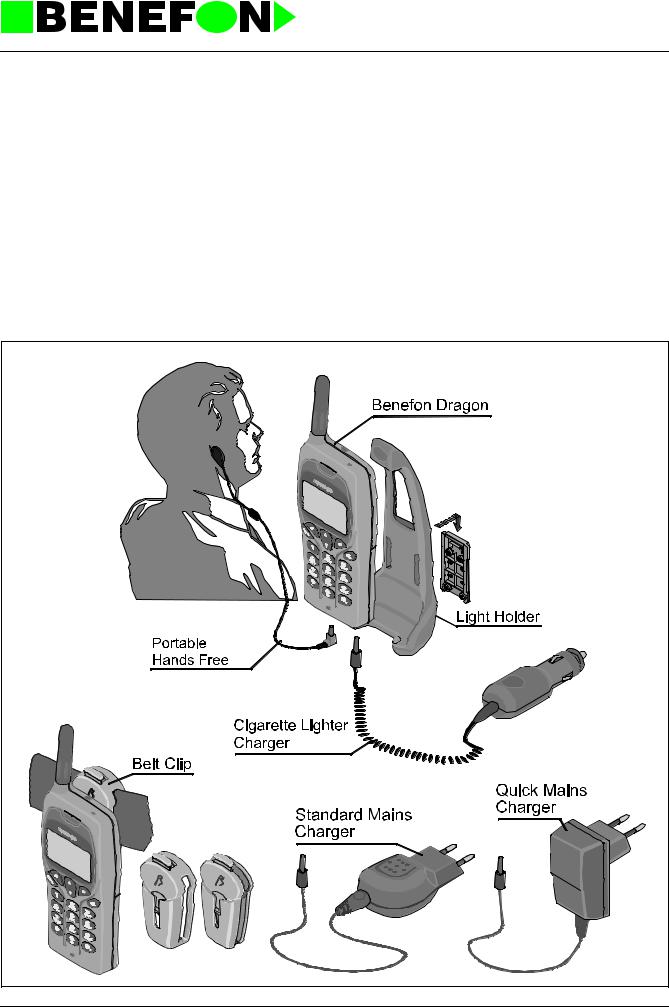
Product: TDP70WN / General
5.9.2000
1.2PRODUCT FAMILY
-BENEFON DRAGON HANDPORTABLE TDP70WN
-STANDARD MAINS CHARGER CSA-70-230
-QUICK MAINS CHARGER CMA-70-230
-CIGARETTE LIGHTER CHARGER CCS-70-12
-LIGHT HOLDER KDC-70
-PORTABLE HANDS FREE EHS-60
-BELT CLIP
2DP_70GB.fm |
4 |

2.0 OWNER’S MANUAL
1user_gb.fm |
1 |

Product: TDP70WN / Installation Instructions
5.9.2000
3.0 INSTALLATION INSTRUCTIONS
Installation Instructions
3.1 Phone Programming
You can program Benefon Dragon by using either the keys on your phone, or the BeneLoc computer program and maintenance adapter. In either case, you will need a localbox.
Programming Menu Commands:
-SALES DATE
-RADIO PATH ID
-OWN NUMBER
-PHONE CODE
-Y1 Y3 ID (additional operator indicator)
-SW VERSION
-SAK
-PRODUCT CODE
-UPDATE LOCALBOX
-INTERLEAVING
-AUTOMATIC ROAMING
-RESET RAM
3.1.1Programming Subscriber ID in Dragon
3.1.1.1How to program the ID in Dragon:
1.Turn on the Dragon normally with its own battery.
2.Hook up the rapid charger until it the phone indicates that it has started charging.
3.Remove the battery and watch that the display shows an empty battery frame.
4.Hook the localbox adapter up to the localbox via the Spica cable, and then attach it to the phone where the battery would normally go.
5.Restart the Dragon.
6.You can get to the ***BENEFON*** menu with the arrow key. Select it, and from there you will find "Radio Path ID", where you can program the ID of the phone.
6DP_70GB.fm |
1 |

Product: TDP70WN / Installation Instructions
5.9.2000
3.1.2To program Using the Phone Keys
1.Connect the QPS50 localbox via maintenance adapter to your phone, and turn the phone on. ,will be flashing in the display in stand-by mode.
2.Press and the following text will appear in the display: ***BENEFON***.
3.1.2.1Sales Date
1.Choose SELECT. The following text will appear in the display:
SALES DATE [XXXXXX].
2. Choose CHANGE. [XXXXXX] will be replaced by the date [daydaymonthmonthyearyear]. Remember to check that the date is correct. If the date is correct, choose SAVE. If the date is incorrect, delete it by choosing and enter the correct date (six digits in the following form: daydaymonthmonthyearyear). To save the date, choose SAVE.
It is possible to program the sales date ONLY ONCE, which means that you will not be able to change it again afterwards. If the sales date has not been programmed, your phone will not enter the normal stand-by mode.
3.1.2.2Radio Path Identification
1.Press , and the following text will appear in the display:
RADIO PATH ID [XXXXXXXXXX].
2.Choose CHANGE. Enter the radio path identification (ten digits), and save the identification by choosing SAVE. Remember to check that the radio path identification is correct.
3.1.2.3Own number
1.Press : own number [+ XXXX...X]
2.Choose CHANGE. Enter the own number (follow the instruction of the operator), and save it by choosing SAVE. Remember to check that the own number is correct.
Note! SMS doesn’t work if the own number has not been programmed.
3.1.2.4Phone Code
1.Press , and the following text will appear in the display:
PHONE CODE [XXXX].
2.Choose CHANGE. Enter the phone code (four digits), and save the code by choosing SAVE.
3.1.2.5Y1 Y3 ID (Additional operator indicator)
It is possible to change old/add new operator indicator which operates in automatic roaming mode. (network selection mode: Automatic)
6DP_70GB.fm |
2 |
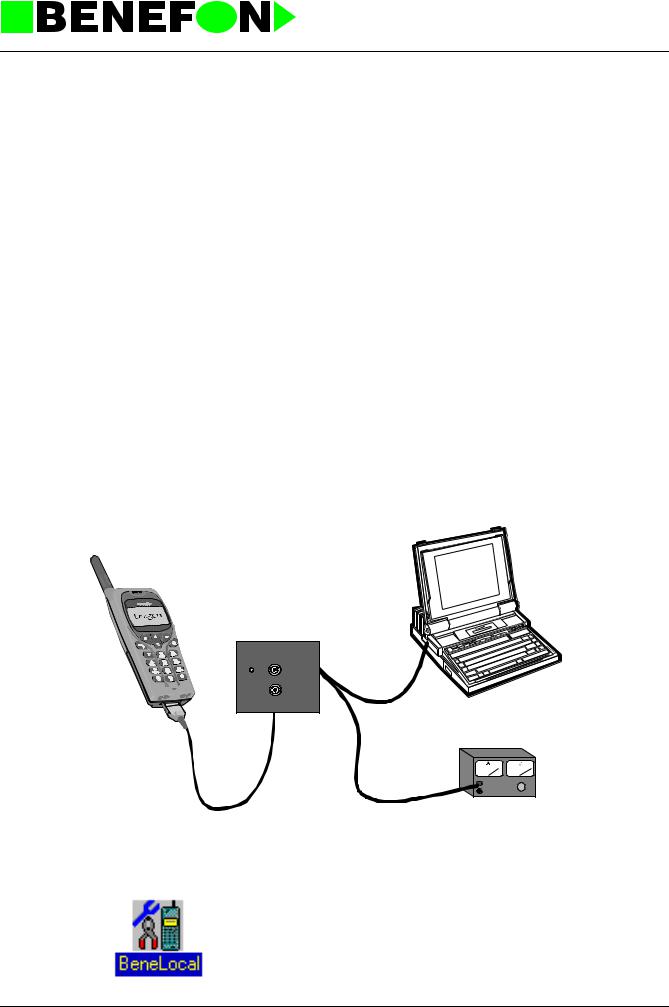
Product: TDP70WN / Installation Instructions
5.9.2000
1.Press : Y1:X Y3:XX ID: ABC
2.Choose SELECT. Enter Y1 (Country code: one digit) and choose
SAVE.
Enter Y3 (Operator code: two digits) and choose SAVE.
Enter ID (Operator indicator, 3 characters) and choose SAVE.
3.1.2.6 Automatic roaming and Interleaving
The Dealer activates or deactives them according to the operator’s or the customer’s likings.
3.1.2.7Closing Instructions
1.Having programmed the necessary information choose QUIT, and the following text will appear in the display: ***BENEFON***.
2.Turn off your phone, and disconnect the localbox.
3.Turn the phone on once more, and make a test call.
3.1.3To program Using the BeneLoc Program
 power
power
5V log |
gen |
 flash
flash
 5V log
5V log
meter
Start the installed program by clicking the icon. The phone must be connected to the system as discribed above.
6DP_70GB.fm |
3 |
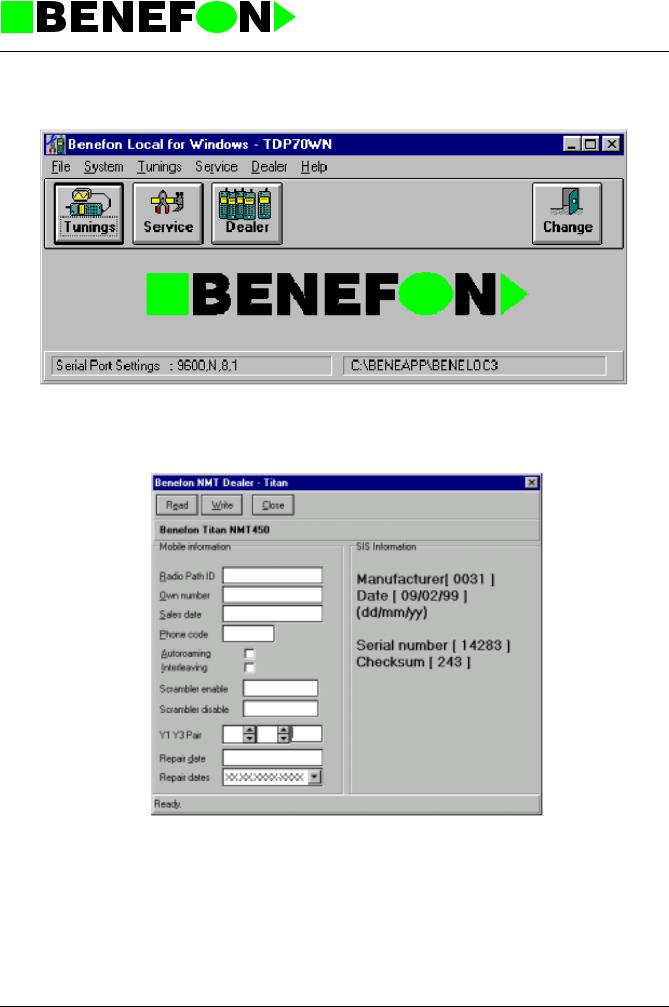
Product: TDP70WN / Installation Instructions
5.9.2000
Main window
Press Dealer-key to enter the programming window.
You can read the phone data by pressing the Read phone -key. You can change the miscellanous settings with the computer and transfer them to phone by pressing the Program phone -key.
BeneLoc includes Help-program for further information.
6DP_70GB.fm |
4 |
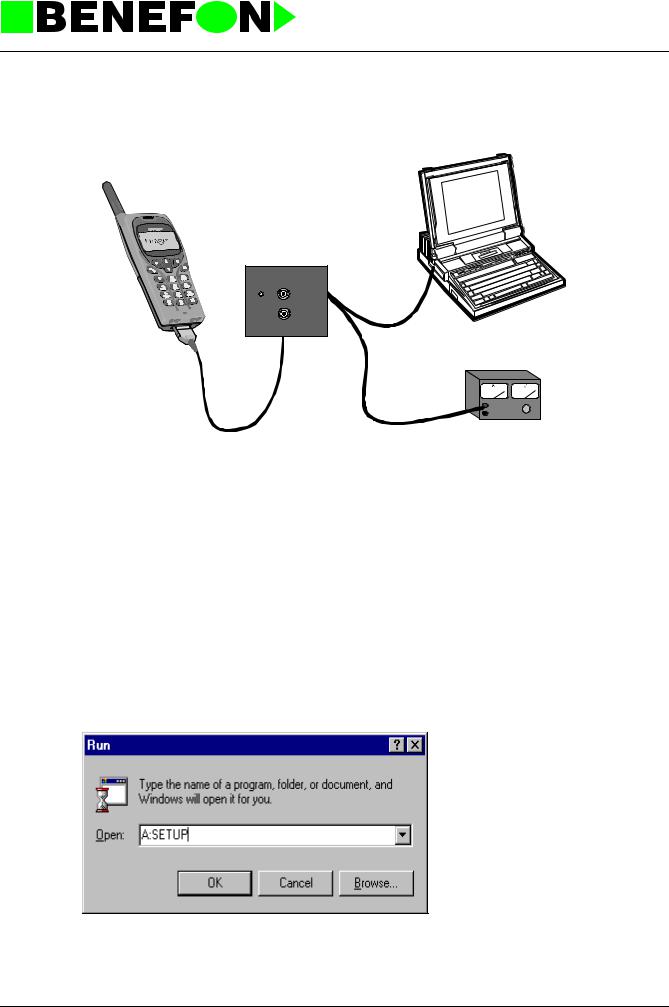
Product: TDP70WN / BeneLoc
5.9.2000
4.0 BeneLoc
BeneLoc
 power
power
5V log |
gen |
 flash
flash
 5V log
5V log
meter
BeneLoc program is designed to help service person on tuning and service purpose. With Flasher Program you can change the software to Benefon phones.
Both, BeneLoc and Flasher program will need Service Adapter, Power Supply and
Localbox with service rights to work.
4.0.1 Installation of BeneLoc program
Start Windows. Close all other programs except Program Manager.
Insert BeneLoc Installation Disc 1 in the floppy disk drive of your computer. In the Program Manager window, choose Run from File menu.
Type the letter A: or B: to indicate your floppy disc drive, and then type SETUP.EXE.
For example, A:\SETUP.EXE.
Click the OK button, and follow the instructions displayed on your screen.
The Setup Program will ask you to specify the drive and directory in which you want
3dp_70gb |
1 |
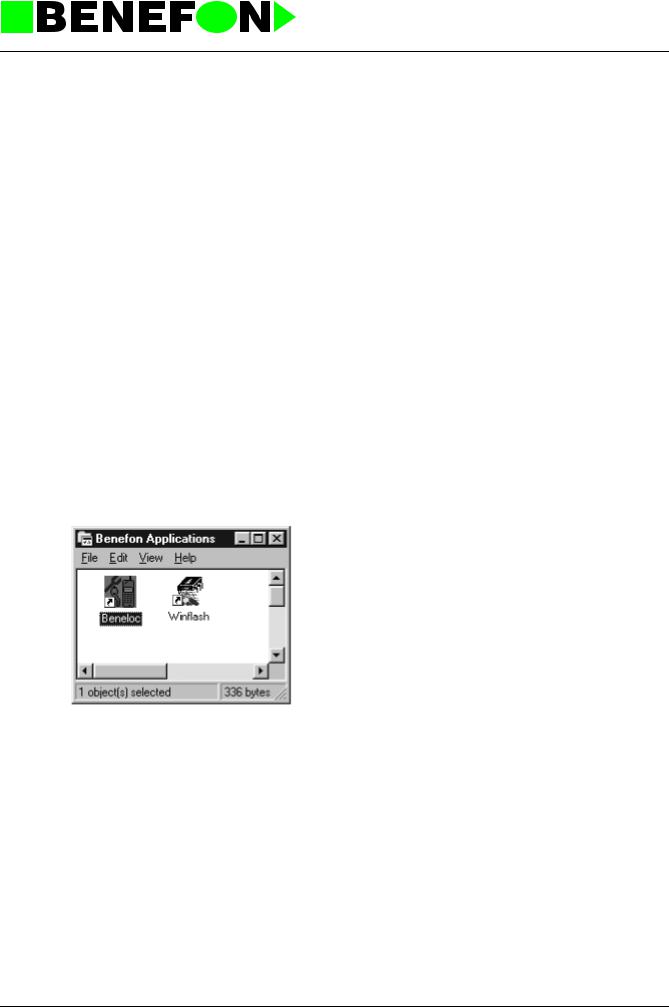
Product: TDP70WN / BeneLoc
5.9.2000
to install the BeneLoc Program. The Program suggests the following: C:\BeneApp\BeneLoc. Accept the drive and directory by clicking Next button. You can also type your own directory for BeneLoc Program.
The Setup Program creates all necessary directories and subdirectories to your computer. Setup Program also creates its own group window in Program Manager.
4.0.2 To start the BeneLoc program
Connect the Service Localbox to serial port of your computer, which is called COM1 or COM2. The serial ports are usually located in the back of your computer, and more precise instructions can be found in the manual accompanying the computer. Adjust the Power Supply voltage to 4.0 Vdc. Connect the Service Localbox to the Power Supply.
Connect the Service Adapter to the phone. Plug the cable with flat connector into the connector at the bottom of the phone. When the cable has been connected and the phone is switched on, the phone should be in LOCAL mode. You can test this by pressing arrow button. There should be ***BENEFON*** on the display, if not, clean connectors and try again. When phone is in LOCAL mode you can start the Bene-
Loc Program.
To start the BeneLoc Program, double click the BeneLoc icon.
In the BeneLoc Startup window, first select the correct serial port. Then, you have to select type of the phone. You can also use the Autodetect option. After selection click OK to start BeneLoc Program. When operating without external power supply the phone may be on sleep mode and registration fails. You can wake up the phone by pressing some buttons on the phone.
3dp_70gb |
2 |
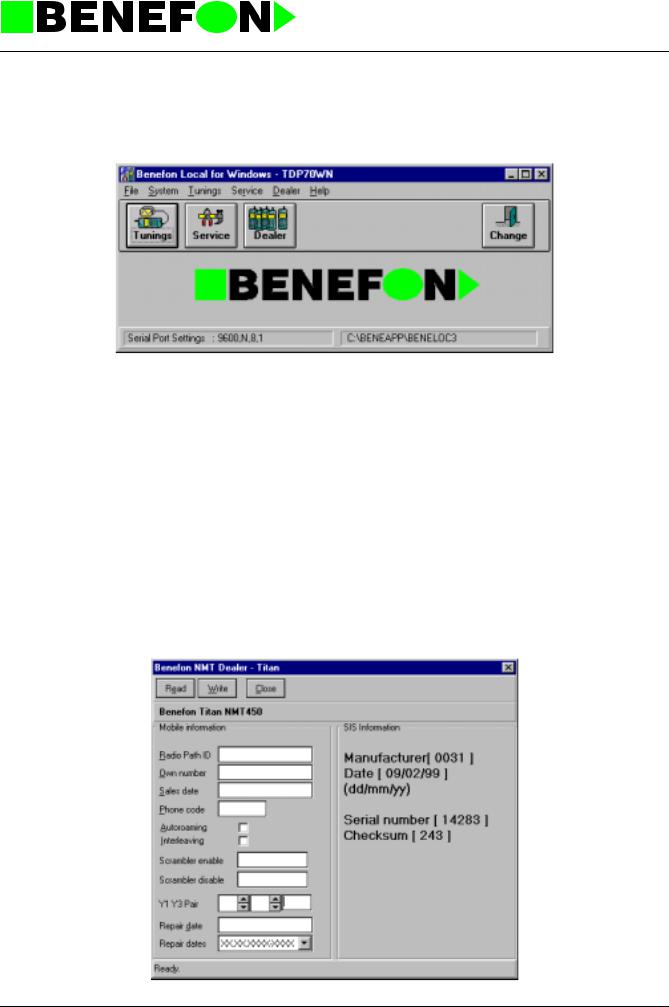
Product: TDP70WN / BeneLoc
5.9.2000
4.0.3 Using the BeneLoc program
In the main window of the BeneLoc, you will find submenus and buttons. Clicking the buttons you can go to the submenus.
Change
For changing phone to another similar you do not need to do more than enter into main menu. It means that this button is not needed. If you are going to change the tested phone to one having different software in, clicking Change will start the registration protocol again.
Help
About BeneLoc submenu will tell you version of the BeneLoc Program and also the state of memory.
About Cellular submenu will show you information of the phone. Type of phones software, sales date, date of the software, serial number and present tuning values of the phone. You can not change the tuning values from Help menu.
Dealer
From Dealer submenu you can make or check programming of the phone. You will also find the SIS information from Dealer submenu.
3dp_70gb |
3 |

Product: TDP70WN / BeneLoc
5.9.2000
Service
You can control the audio lines (for example, switch Rx audio and compander on/off) in the Service main menu. It is also possible to control the phone to desired channel. There is also possible to change the power of transmitter.
In the Ports submenu is you can see the status of different digital ports. There is also possible to control some of the output ports.
You can read the status of the A/D converters from the A/D submenu. Select 8 different topics to view. By clicking SCAN AD button The Beneloc will scan A/D the state of converters continuously. Scanning can stopped by clicking STOP AD.
Memory submenu allows you to make Ram reset.
By clicking Initialize You can clear all LOCAL settings in service menu.
Home button will return you back to main menu.
Tunings
From Tunings main menu you can select different tunings to do. Every tuning have they own instruction window. Follow given instructions to do tunings. Clicking
START will start tuning. The value will be stored only by clicking SAVE. Some of the tunings are chained and you can enter to next phase by clicking NEXT.
4
3dp_70gb |
4 |

Product: TDP70WN / BeneLoc
5.9.2000
System
You select used mobile phone system from this submenu.
File
From settings submenu you can manually change settings of the communication port.
3dp_70gb |
5 |

Product: TDP70WN /
5.9.2000
5.0 PHONE’S CONSTRUCTION
0 A0 E32
7dp_70gb |
1 |

Product: TDP70WN / OC2285 Processor/Audio/RF
5.9.2000
LOGIC / AUDIO
OC2285 Processor/Audio/RF
5.1 PROCESSOR
5.1.1 General
The entire radio: The audio, processor and RF functions are found within a single OC2200 board, along with the display and keyboard.
The processor controls the audio and radio (RF) parts, internal devices and external accessories.
The µCBIC (processor-asic) includes:
µCBIC IG3010
PROM 29DL800BT
SIS IG2048
H8/300H-cpu, 10k*8 CMOS RAM, 8 A/D, 4 D/A, 48 pcs I/O lines,3 series-interfaces, 2 modem-interfaces, i2c-interface, frequency counter, realtime clock
Flash program memory
Asic for SIS-function, 256k*8 EEPROM + Universal EEPROM for tuning values
5.1.2Connectors:
5.1.2.1Connector for service purposes only
1 |
V-PROG |
flash programming voltage |
0.5/12 -14 Vdc |
2 |
GEN_OUTPUT |
rx audio signal output |
100 mVrms |
3 |
CHGDET |
charger detector |
0/VCC digital |
4 |
SCL |
i2c clock |
0/VCC digital |
5 |
SDA |
i2c clock |
0/VCC digital |
6 |
TXDO |
RS232 output |
0/VCC digital |
7 |
GEN_INPUT |
tx audio signal output |
200 mVrms |
8 |
RXDO |
RS232 input |
0/VCC digital |
5.1.2.2 Headset connector, V2
1 |
HFMIC |
microphone signal input |
10 mVrms |
2 |
HEADSET |
headset detector |
0/VCC digital |
3 |
HFERP |
earphone signal output |
100 mVrms |
4 |
GND |
ground |
|
4Z2200GB.fm |
2 |

|
|
|
Product: TDP70WN / OC2285 Processor/Audio/RF |
|
|
|
|
5.9.2000 |
|
|
|
|
|
|
|
|
|
||
|
5.1.2.3 Charger connector, V6 |
|
||
1 |
Charger voltage |
6 ...10 V DC |
|
|
2 |
Ground |
|
|
|
|
5.1.2.4 Battery connector, V5 |
|
||
1 |
Ground |
|
|
|
2 |
VB_unfiltered |
3.6 V |
|
|
|
5.1.2.5 Battery identification connector, V4 |
|
||
1 |
Bat_type_1 |
0/VB digital |
|
|
2 |
Bat_type_2 |
0/VB digital |
|
|
|
5.1.2.6 Display and keyboard connector, V3 |
|
||
1 |
GND |
|
|
|
2 |
KEYIN0 |
key matrix input |
0/VCC |
|
3 |
KEYIN1 |
key matrix input |
0/VCC |
|
4 |
KEYIN2 |
key matrix input |
0/VCC |
|
5 |
KEYIN3 |
key matrix input |
0/VCC |
|
6 |
KEYIN4 |
key matrix input |
0/VCC |
|
7 |
KEYOUT0 |
key matrix output |
0/VCC |
|
8 |
KEYOUT1 |
key matrix output |
0/VCC |
|
9 |
KEYOUT2 |
key matrix output |
0/VCC |
|
10 |
KEYOUT3 |
key matrix output |
0/VCC |
|
11 |
PWRSW |
key matrix input |
0/VCC |
|
12 |
PWRKEYIN |
powerkey |
0/VCC |
|
13 |
GND |
ground |
|
|
14 |
VCC |
LCD power supply |
VCC |
|
15 |
RESET |
reset signal |
0/VCC |
|
16 |
DCS1 |
display chip select |
0/VCC |
|
17 |
DAO |
L:control data H:display data |
0/VCC |
|
18 |
DSCL |
serial clock line for data |
0/VCC |
|
19 |
DSI |
serial data input |
0/VCC |
|
20..31 |
|
connected to the voltage components |
|
|
32 |
GND |
ground |
|
|
4Z2200GB.fm |
3 |

Product: TDP70WN / OC2285 Processor/Audio/RF
5.9.2000
5.1.2.7 Circuit Diagram
The processor, audio and RF circuits diagram is split into seven parts. Signals in the circuit diagrams have been given names, and signals with the same name are connected between diagrams (<x> = page).
Page |
1 of 7 |
module connector pins |
|
2 of 7 |
power supply + display |
|
3 of 7 |
µCBIC, EPROM, SIS-function |
|
4 of 7 |
audio parts |
|
5 of 7 |
synthesizer |
|
6 of 7 |
receiver |
|
7 of 7 |
transmitter |
5.1.3Functions
5.1.3.1µCBIC
I3 is itself a processor-asic circuit. It is comprised H8/300H-cpu, 10k*8 CMOS
RAM, 8 A/D, 4 D/A, 48 pcs I/O lines, 3 series-interfaces, 2 modem-interfaces, i2c-interface, frequency counter, realtime clock, timers and 4,8 MHz clock oscillator. The µCBIC divides this by 4 to get timing signal E.
When the processor is operating, RESET = VCC, VCC = 2.8 V, E = 1.2 MHz.
5.1.3.2 Memories
Memory and external I/O-circuit address coding is done with the µCBIC circuit
I3. The circuit options CE, OE and WE are 0-active.
The program memory is in 8 Mbit Flash memory 29DL800.
RAM-memory is 10k*8 CMOS RAM and included in the µCBIC. µCBIC uses its own power supply voltage which is VRAM and is always operating, even when the radio is in the OFF state.
5.1.3.3 The Modem
The FFSK modem is located in the audio circuit. The modem is connected to the µCBIC by a series line, input to synchronised port, and transmission is controlled by an µCBIC series output. The modem gives a 1200 Hz signal RXCLK and TXCLK to the µCBIC. There is a data detector within the modem, the speed of which is controlled by C57. The µCBIC A/D converter measures the level of acceptance from ERPDET line. The same detector also serves to control HF function.
5.1.3.4 AFC
The AFC function is performed by an internal µCBIC frequency counter. A 450 kHz intermediate frequency is amplified to a square-wave form by Q5. The
4Z2200GB.fm |
4 |

Product: TDP70WN / OC2285 Processor/Audio/RF
5.9.2000
frequency is adjusted by µCBIC D/A 1 signal. This approx. 1.5 Vdc voltage is fed to the synthesiser AFC pin.
5.1.3.5 Sleep Timer
The phone puts the central functions to sleep for a time. Although everything seems normal to the user, but most of the functions are closed down. The radio and audio units are closed down completely. The processor still has a power supply, but the processor is halted and has minimal power consumption. Only the µCBIC circuit sleep timer and its 32 kHz crystal oscillator remain in active mode. The phone is "woken up" by interrupting the sleep timer or by changing the keyboard state. The sleep timer 32 kHz clock frequency is produced by the oscillator made by crystal X1.
5.1.3.6 Warm start
C32 and R38 measure the length of a voltage break. The voltage drops during a break, after which it is measured by the A/D (AN2) converter. The time constant is approx. 10 s. Thus a "warm start" is detected.
5.1.3.7 Reset
The output (VCC) of the main voltage regulator I11 is connected to the power supply reset monitor I1. The output of I1 resets (stops) the processor and zeroes the controls when the battery voltage drops below 2.6 V. When the voltage rises again, the processor restarts.
5.1.3.8 Power Switch
When the power switch is pressed, the PWRSW line goes to high state and drives the regulator to operate. The program commences and checks the
PWRSW line to ensure that the switch is being pressed, and sets hold on the regulator for the PWRON line. When the switch is depressed for a longer time, the program directs power to the PWROFF line. During a short voltage break,
C1 remembers the previous control, i.e. C1 keeps the control voltage high when the battery voltage is restored within 10 seconds. C1 also serves as a watch-dog should the voltage drop or processor error-state continue; after 10 seconds, the radio will shut down completely.
Note1! When the phone is operative, the same power power switch acts also the # key.
Note2! The µCBIC circuits have their own power supply voltage connected to the battery to ensure an uninterrupted power supply. The µCBIC power supply is ensured during a battery-back change by the battery B1.
5.1.3.9 Battery Voltage Measurement
The battery voltage is measured by an A/D converter (AN7). The reference voltage for the measurement is provided by the main regulator 2.8 V supply.
Calibration is done by the program against a precisely known battery voltage.
4Z2200GB.fm |
5 |

Product: TDP70WN / OC2285 Processor/Audio/RF
5.9.2000
5.1.3.10 I/O ports
The µCBIC I/O ports PA PF are 8-bit hold circuits. Data is fed to the addresed output. When the RESET line is down (0V) all the µCBIC ports are zeroed (0V). As RESET rises again, all of the two-way I/O ports are inputs until the program sets them to the desired state. With the radio in OFF state, RESET is down so all of the controls are also down although µCBIC is still provided with operational voltage VRAM.
5.1.3.11 SIS
SIM is performed by a BENEFON ASIC IG2048 manufactured by Atmel. Integrated circuit IG2048 is E2 logic array. This type of array incorporates both an electrically erasable and programmable read only memory (EEPROM) and a gate array for SIM function.
SIM has 256 bytes internal EEPROM divided to two parts: 224 bytes EEPROM for universal use and 32 bytes EEPROM for SIS calculations are secured by programmable fuse function.
User specific information is stored in EEPROM which CANNOT be read from outside the chip. All external attemps to read the information clear both. EEPROM and RAM (fill with FF).
5.1.3.12 Power Adjustment
The transmitter control logic switches TX power and also adjusts it to the correct level. The TXS_REG signal sets the transmitter to ready mode. Power is controlled by the µCBIC analog output A/D 0 through the TXPWR line. 0 V corresponds to "no power" and 2.8 V to maximum transmitter power. The power levels are calibrated by the program at the source of measurement.
5.1.3.13 Charging Control
The charger is controlled by the program. The charger is detected by a voltage at the CHGDET pin. The charging current is controlled with Q10 which acts as a switch. The switch Q10 is controlled by Q4 through the charge_on -line.
5.1.3.14 Temperature Measurement
The radio has one temperature sensor R72, situated just under the battery pack. Inside the radio the NTC resistor R72 voltage is measured by the µCBIC
A/D converter (AN6). This value is converted by a programmed table to a temperature reading.
5.1.3.15 Real-time Clock
A real-time clock is provided within µCBIC to give the time and date. The alarm function can also be programmed to the ALARM pin. This will initiate the main regulator and thus also the radio although it is in OFF state.
4Z2200GB.fm |
6 |
